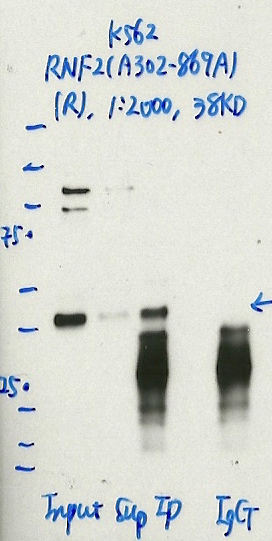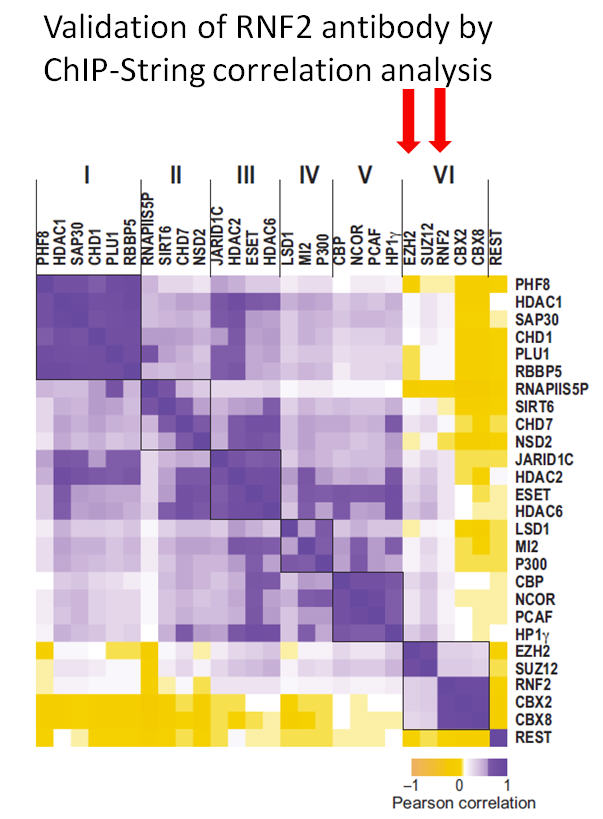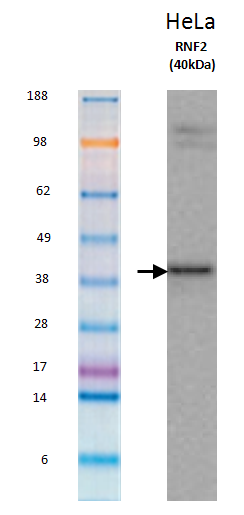ENCAB790JUW
Alternate accessions: ENCAB000AKK, ENCAB729RXO
Antibody against Homo sapiens RNF2
Homo sapiens
K562
characterized to standards
Homo sapiens
H1, HeLa-S3
characterized to standards with exemption
- Status
- released
- Source (vendor)
- Bethyl Labs
- Product ID
- A302-869A
- Lot ID
- 1
- Characterized targets
- RNF2 (Homo sapiens)
- Host
- rabbit
- Clonality
- polyclonal
- Purification
- affinity
- Aliases
- michael-snyder:AS-1278, bradley-bernstein:PchAb 155
- External resources
Characterizations
RNF2 (Homo sapiens)
K562
compliant
- Caption
- Immunoprecipitation was performed on nuclear extracts from the cell line: K562, using the antibody A302-869A. The blot shows western blot analysis of input, flowthrough, immunoprecipitate and mock immunoprecipitate using IgG.
- Submitted by
- Denis Salins
- Lab
- Michael Snyder, Stanford
- Grant
- U54HG006996
- Download
- 1047_07_RNF2_A302-869A.jpg
RNF2 (Homo sapiens)
not reviewed
- Submitted by
- Charles Epstein
- Lab
- Bradley Bernstein, Broad
- Grant
- U54HG004570
RNF2 (Homo sapiens)
H1HeLa-S3
exempt from standards
- Submitter comment
- The antibody review board chose to exempt this for H1-hESC and HeLaS3 given the K562 results and the age of this data.
- Reviewer comment
- Confirmed that this was given an exemption for H1-HESC given the results of K562.
- Submitted by
- Charles Epstein
- Lab
- Bradley Bernstein, Broad
- Grant
- U54HG004570
RNF2 (Homo sapiens)
K562
compliant
- Caption
- Immunoprecipitation was performed on nuclear extracts from the cell line K562 using the antibody A302-869A. Lane 1: input nuclear lysate. Lane 2: material immunoprecipitated with antibody. Lane 3: material immunoprecipitated using control IgG. Marked bands were excised from gel and subjected to analysis by mass spectrometry. Target molecular weight: 37.655.
- Submitted by
- Nathaniel Watson
- Lab
- Michael Snyder, Stanford
- Grant
- U54HG006996
- Download
- MS1023_3_RNF2-A302-869A.JPG
RNF2 (Homo sapiens)
Method: immunoprecipitation followed by mass spectrometry
compliant
- Caption
- IP followed by mass spectrometry. Briefly, protein was immunoprecipitated from K562 nuclear cell lysates using the antibody A302-869A, and the IP fraction was loaded on a 10% polyacrylamide gel (NuPAGEBis-Tris Gel) and separated with an Invitrogen NuPAGE electrophoresis system. The gel was stained by ColloidialCoomassie G-250 stain, gel fragments corresponding to the bands indicated were excised. Then proteins were trypsinized using the in-gel digestion method. Digested proteins were analyzed on an Orbitrap Elite mass spectrometer (Thermo Scientific) by the nanoLC-ESI-MS/MS technique. Peptides were identified by the SEQUEST algorithm and filtered with a high confidence threshold (Peptide false discovery rate < 1%, 2 unique peptides per protein minimum, mass error < 10 ppm).
- Submitted by
- Nathaniel Watson
- Lab
- Michael Snyder, Stanford
- Grant
- U54HG006996


